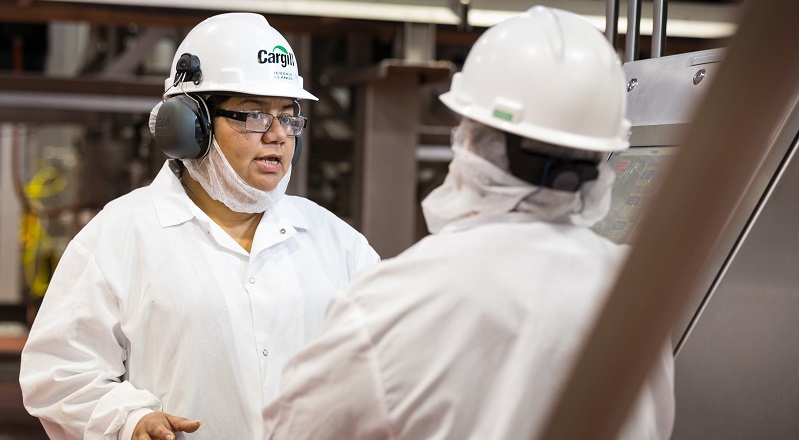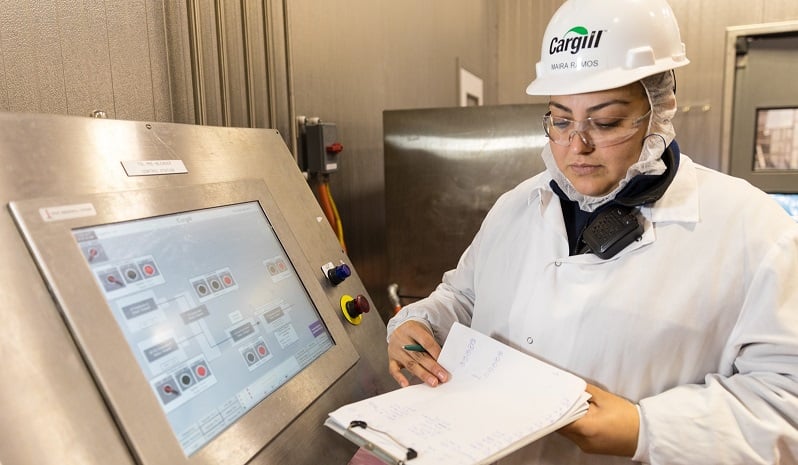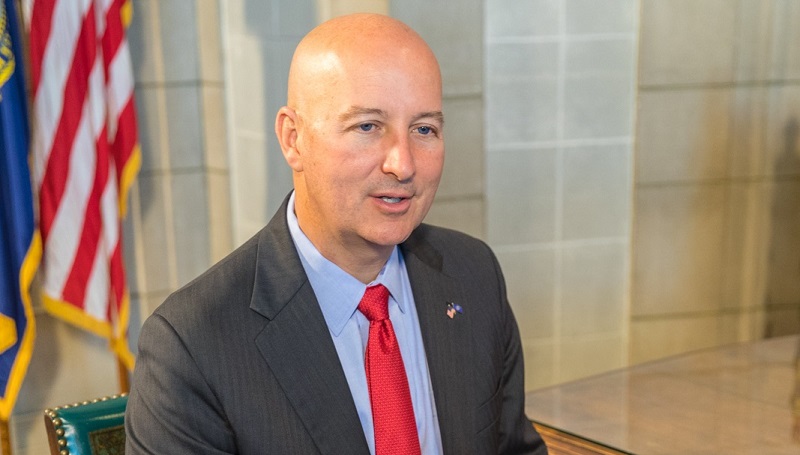A life-changing expansion
When Cargill closed a Nebraska beef plant for renovation, the employees got a chance to go back to school.
February 14, 2018
Maira Ramos didn’t have to stay, and Cargill didn’t have to keep her.
When the company’s protein plant in Columbus, Nebraska, shut down for nine months to undergo sweeping renovations, she— along with dozens of her coworkers—lost her job with no guarantee she’d get it back.
She didn’t have to get on a school bus, fight through blizzards and language barriers and spend what used to be her workday forging her own future in a classroom. Her colleagues didn’t have to compile lesson plans and teach her. Her managers didn’t have to make sure she was getting there or fight for the grants to pay for it.
The state didn’t have to approve the unprecedented public-private partnership. The company didn’t have to sign off on it. And she didn’t have to stick with it when it was frightening, when it was challenging, when progress was slow and the payoff uncertain.
This is the story of why they did.
An opportunity to expand
A city of about 22,000, about 80 miles west of Omaha, Columbus is a city of workforce giants. Bolstered by rail and the confluence of the Loup and Platte Rivers, companies like medical device maker Becton Dickinson and electronics manufacturer Vishay scoop up employees by the thousands. Until December 2015, Cargill’s plant employed 240 people to process beef patties and frozen meats.
Then came a big opportunity: The company struck a deal to supply Taco Bell with seasoned ground beef. It was a major partnership that called for a significant investment—$111 million to expand the plant and convert it to a cooked meats operation.
The construction would take the facility offline for six to nine months. Amid the excitement, the plant’s management team was quick to ask: When the work is done, who will be here to run the facility?
A small core group was already slated to stay on the payroll during the downtime. But about 160 production workers—the vast majority of them meat packers, many of whom had been with the plant long before it was even a Cargill facility—were not. Losing them would be a blow under any circumstances. Losing them at a facility that would require nearly twice as many workers to operate once it reopened would be harder still.
And losing them in Nebraska, one of the tightest labor markets in the country, would be devastating. Even in the depths of the great recession, the state’s unemployment rate never cracked five percent. Today in Platte County, it hovers just under 3 percent. Competition for workers is fierce. Cutting ties with dedicated employees wasn’t something the plant was prepared to do.
“What am I going to do?”
“We were concerned that if we had to terminate all of the employees, we would never get them back,” said Kim Schumacher, human resources manager at the facility.
She and her colleagues convinced the company to keep half of the workers—those in the highest-skill jobs—on the payroll through the shutdown. The news was still difficult. Those staying were dismayed that many longtime friends and colleagues might not return. Those who were not staying didn’t know what would come next.
“I was sad and I was scared,” said Ramos, a four-year employee. “It was, ‘what am I going to do? I could go somewhere else, but I like this job.’
The company put together severance packages and insurance extensions for the displaced workers, and enlisted the local Department of Labor office to get help filing unemployment benefits and putting together a job fair.
It soon became apparent they would face limited options in the job market. Nearly 90 percent of employees spoke Spanish at home, and most had limited English and literacy skills. Fewer than half had reliable access to the Internet. Just 56 percent had finished a high school education.
“We knew that one of two things were going to happen,” said Bernadette Hansen, the regional workforce development manager for the Nebraska Department of Labor in Columbus who worked closely with Cargill. “These people were going to move back to their native country, or they were going to leave the state, and we did not want that.”
Instead, she and Schumacher—along with Central Community College—hatched a plan.
Back to school
Doug Pauley, the director of training and development for Central Community College in Columbus, has no shortage of experience in adult education. His campus enrolls about 20,000 people a year and offers programs in everything from high school equivalency test preparation to leadership development to welding. But even by his standards, the request that came in late 2015 was a handful.
Marshalling together myriad resources—local and state labor officials, the Nebraska Department of Education, the Educational Services Unit network, the Columbus Family Resource Center, Platte Valley Literacy services—Schumacher, the Cargill team and Central Community College put together an ambitious plan. Every employee affected by the plant shutdown, both those that would be retained and those whose future was uncertain, could enroll in 36 weeks of classes.
Spanish-speaking production workers could study things like English, computer skills and financial literacy. Managers could learn Spanish and take leadership courses. Those with advanced skills could take college-level courses for credit. Classes would run five hours a day, five days a week.
For employees staying on, the program would help develop the skills to run high-tech equipment in the new plant. For those who might not, it would lay the foundation for whatever the future held.
Meeting the challenge
One-hundred-sixty-eight people decided to enroll. “Finding out that they wanted to involve everyone at every level in training programs, it was a massive undertaking, but one we knew we could handle,” Pauley said.
Between late October and the start of the new year, he needed to find instructors who could teach 90 classes a week, administer placement tests, order materials, figure out how to track attendance and measure progress. For backup, he enlisted Ann Chambers, Central Community College’s education director and a 30-year veteran in adult education.
 168 employees decided to participate in the retraining program.
168 employees decided to participate in the retraining program.
Logistically, “it was a nightmare,” Chambers said. Many college offices, like purchasing, shut down late in the year for the holidays. Pauley hired 25 instructors, some out of retirement, and tapped some Cargill employees to teach a few classes. The books they ordered made it as far as a warehouse in Omaha; on New Year’s Eve, Pauley drove to pick them up.
“It was a challenge,” Chambers said, “but we met it, and we were thrilled.”
The state stepped in with a $465,000 Department of Labor grant to help pay for the classes. Labor Commissioner John Albin also made a ruling that workers enrolled in the training program would be eligible for unemployment benefits without the typical requirement that they actively look for new jobs.
Albin saw it as a golden opportunity to invest in the kinds of skills critical to a modern workforce.
“The old-style, blue-collar jobs that were basically back-and-sweat type of jobs have pretty much gone away,” he said. “It requires a much more skilled workforce now.”
By January 4, 2016, the pieces of the training program were in place. A blizzard was raging, but the participants showed up at the plant, grabbed Cargill backpacks and got on a bus.
“I’m going to do the best I can.”
When the plant closure was announced, Isabel Weier, a member of the Cargill Columbus human resources team and the facility’s translator, had to break the news in Spanish. A few months later, she found herself in front of many of the same people, asking them to write down a word they knew in English.
Weier, along with a few of her colleagues, had been recruited to teach some of the classes. She was in charge of teaching basic writing, covering everything from pronouncing letters to spelling colors to writing a check. Her colleagues-turned-students—already accustomed to seeking her help with documents and paperwork— were comfortable with her.
Now it was their turn. On the first day of class, when she asked for a word—any word—“a lot of their papers were blank,” she said. “There were maybe a couple people that had one word.”
For Jessica Llanos, it was daunting. The single mother of two boys had worked at the plant for seven years and knew she would keep her job, but she was still nervous about putting her language skills into practice. After her placement test, she couldn’t help but think, “what if they see I’m not ready for this?”
But her teachers gave her the confidence to speak up and ask questions. She leaned on her classmates who were stronger with the language, sending texts and emails when she needed help.
She put an application on her phone that helped her look up and pronounce unfamiliar words.
She was determined: “I’m going to do this, and I’m going to do it good. I’m going to do the best I can.”
Lessons beyond the classroom
Others brushed up on their technical skills. Maira Ramos got more comfortable using a computer—critical in a revamped modern facility where much of the equipment is operated and monitored by touch screen. Julissa Lira Quezada, a production lead, took college-level Microsoft certification courses, figuring it was a once-in-a-lifetime opportunity.
“I got paid to go to school,” she said. “That doesn’t happen.” Josua Jacinto, a floor trainer, overcame his fear of going back to school for the first time in nearly 20 years to pass his computer and psychology classes with flying colors. Edder Hernandez, in maintenance, got a jump-start on the degree he was already working on by taking classes like Mechatronics and Motor Controls. Back at the plant, he found himself putting his newfound expertise in rebuilding panels to work.
 Maira Ramos learned the skills she needed to control equipment operated by touch screen.
Maira Ramos learned the skills she needed to control equipment operated by touch screen.
Karla Burks, one of the language instructors in the program, could tell her students knew plenty—they were just afraid to express it at first. They shed those worries as they went along, gaining confidence as they went through real-life situations—how to navigate the supermarket, how to go to the post office and ask for stamps.
“It’s not just gaining all the knowledge in the books,” she said. “It’s showing them that they can do it and helping them feel comfortable.” Perhaps most importantly, the students wanted to be there. Janis DeHaven, a Microsoft certification and computer science instructor, remembers a slow start as she and her students worked through language barriers. But after the first month, “we were rolling.”
When it came time for students to showcase their new Power-Point skills, they decided, collectively and unprompted, that the occasion called for formal business attire.
“They truly did appreciate it and took it seriously,” she said. “They had such a deep desire to learn.”
No more help needed
By the end of the semester, Weier’s class, which had struggled to summon a single word, was filling pages. Burkes’ students were chatting with her in English. Some made progress on taking high school equivalency tests. Some earned professional certifications and college credit.
Everybody got a graduation ceremony. Students presented their instructors with thank-you plaques. Their families packed the room. Everybody cried.
It was just a certificate, but that didn’t matter. People could suddenly make doctor’s appointments on their own. They started attending parent-teacher conferences because they could understand. Those who used to need a translator for everything now acted as the translator for friends and neighbors.
Weier noticed English- and Spanish-speaking employees at the facility spending more time together. One woman said she’d never been able to read to her 5-year-old son. Now she does so every night. Another couple had never been able to order a hamburger from a drive-through. Now they do it every week, just because they can.
Susie Jirka, a high school equivalency examiner, math and computer teacher in the program, ran into one of her students at the airport in Omaha. They were carrying on a casual conversation—a feat unto itself—when he pulled out his wallet and showed her a piece of paper she had given him early on in class when he was struggling a little. It was a note with her contact information to let him know she’d be there if he needed help. He didn’t need it anymore; he kept it anyway.
“He proved to me that with hard work and perseverance, he could accomplish something amazing,” she said. “It’s going to have a ripple effect from individual hearts to families to entire communities.”
Reskilled, ready for the future
When the plant reopened in January 2017, overall employment more than doubled and previous positions were reclassified. Almost all of them paid better to reflect the higher skill requirements. The average wage for a worker retained through the shutdown went up more than $2 an hour. About 90 percent of those who were laid off are back at the plant in more skilled positions.
“Not only did the educational program impact our employees’ lives, but also enhanced the reputation of Cargill throughout our community,” said Scott Chaney, the plant manager. “Local leaders raved about not only what we had done for our employees, but also how our employees had contributed through numerous community service activities. We’re so grateful to all our partners and the governor for helping make this happen.”
That credibility paid off when it was time to ramp up hiring for full production: In spite of the community’s low unemployment rate, the plant received more than 500 applications for open positions.
Pauley, Hansen and Albin all called the program the most rewarding project they’d worked on in their respective careers. Pete Ricketts, the governor of Nebraska, took notice, touring the new plant and citing the project as an exemplar of public-private partnerships.
 “This is really how it’s supposed to work," said Nebraska Governor Pete Ricketts. “It’s a fantastic success story.”
“This is really how it’s supposed to work," said Nebraska Governor Pete Ricketts. “It’s a fantastic success story.”
“This is really how it’s supposed to work, when you bring all the different stakeholders together to be able to focus on what we can do to make sure the people who are going to be impacted have the job training they need to be able to take that next job,” Ricketts said. “It’s a fantastic success story.”
Edder Hernandez got a promotion to a maintenance lead role. Maira Ramos wasn’t sure if she’d even have a job waiting for her; she was ecstatic to learn her training paid off with a jump from packer to blender operator.
Armed with new language skills, Jessica Llanos is far more confident asking questions and making suggestions at work. The leadership courses she took have helped with her two boys at home. But the biggest change is a newfound sense of purpose. She wants to finish her high school degree and go to college. She feels like the company and her teachers have her back. And she feels like what she does matters.
“I’m a big part of this,” she said. “In the past, I would just come, do my job, finish the batches I needed to do, and go home. Now, I feel …”
She pauses for a moment to search her phone for the word, holding it up to her ear to make sure she’s saying it right.
“Commitment.”
